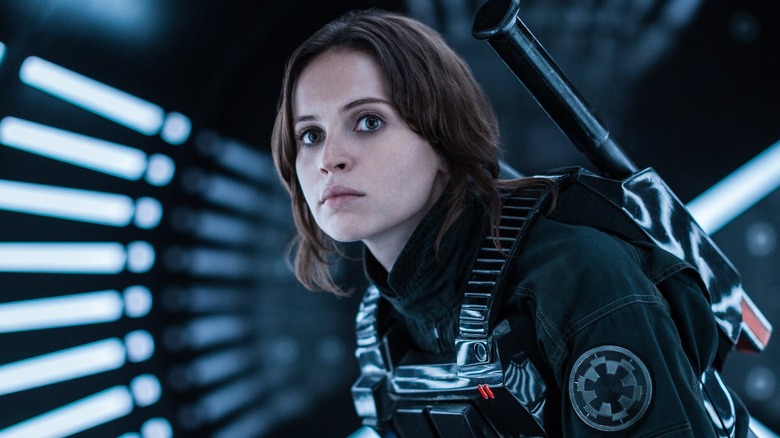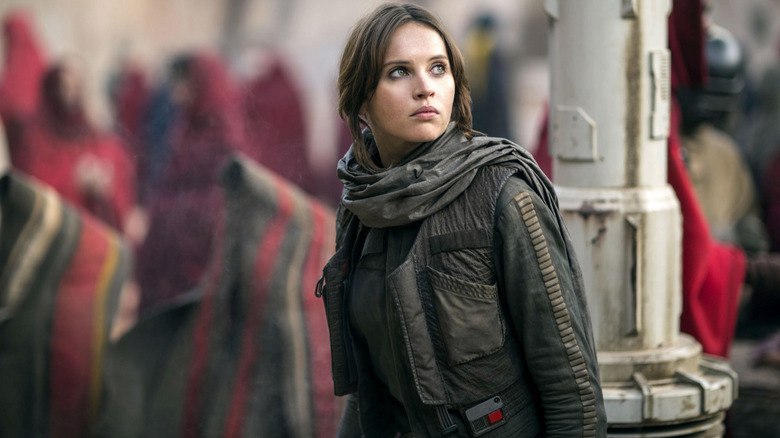The Original Plan For Rogue One Had Jyn As A Jedi's Daughter
Some of the best "Star Wars" stories are those that give us a break from those drama queens known as the Jedi and shift their focus to how the other side lives in a galaxy far, far way. In a setting populated by space wizards, witches, and mystical entities, there's something instantly relatable about common folk who know nothing of the Force and are, to borrow a turn of phrase from Jango Fett, simple men and women trying to make their way in the universe. It's similar to why everyone loves hobbits in "The Lord of the Rings." (That and they're good-natured stoners, obviously.)
While "Andor" has realized the full potential of this approach, it was its predecessor, 2016's "Rogue One: A Star Wars Story," that paved the way and has, in return, taken on deeper dimensions thanks to its prequel series. The film's protagonist, Jyn Erso (Felicity Jones), has no ties to the Jedi; she's torn from her biological family at a young age by the Galactic Empire and grows up to become a jaded young woman. Her desire for a new home drives Jyn's actions, allowing her to swiftly bond with the kindred spirits she finds in Cassian Andor (Diego Luna) and the other members of the eponymous Rebel squad.
However, "The Art of Rogue One: A Star Wars Story" reveals that early versions of the script not only made Jyn's mother a Jedi hiding from the Empire, but it also gave Jyn a young brother to care for and watch over. In the actual film, Jyn has no siblings and her mother, a non-Jedi named Lyra (Valene Kane), is killed by the Empire after she and Jyn's father Galen (Mads Mikkelsen) — one of the chief architects behind the Death Star — flee the Imperials in the hopes of preventing Galen's world-destroyer from ever being completed. (Galen is indeed the Oppenheimer of "Star Wars.")
Jyn is a Star Wars hero for the modern age
"From our first meetings, [director] Gareth [Edwards] had us drawing pie charts to break down the acts — the first act, the second act, the third act," explained "Rogue One" concept artist Erik Tiemens. He added that, even in early script drafts, Jyn's journey was "always a circle, from our hero's family home to an underworld to the rallying of the troops, and Gareth always wanted to get Jyn back home again; it starts with the home and ends with [a metaphorical] home."
It's interesting to contrast Jyn's backstory with that of Luke Skywalker in "Star Wars: Episode IV — A New Hope." Where Luke grows up far removed from the hardships of war before undertaking his grand adventure, Jyn is tossed out of the pan and into the fire when she's only a child. "Luke's a boy who grew up out of the way and who dreams of joining the war, and Jyn is a girl who's grown up in war and wants to find a way back home," Tiemens noted. "The essence of that is the same; it's the hero's journey –- leaving home, finding the truth and facing the enemy, and returning [to a metaphorical] home."
This, coupled with her lack of connections to the Jedi, is also what makes Jyn a fitting "Star Wars" hero for the modern age. "A New Hope" came out of George Lucas reacting to the horrors of the Vietnam War and Richard Nixon's presidency in the '70s following his gentler upbringing in '60s Modesto, California (a world he memorialized in his wistful 1973 coming-of-age piece "American Graffiti"). His loss of innocence mirrored that of Luke's and other (white, male, middle-class) Boomers. Those who've grown up in the 21st century, on the other hand, are more like Jyn, having dealt with relentless political unrest and social instability the world over. For them, war is nothing to dream about.

